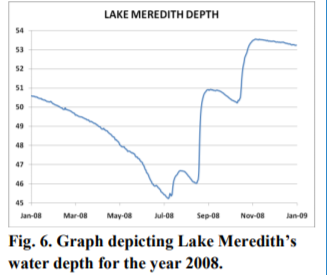Water Levels Rise at Lake Meredith
Anyone who has lived in the Panhandles for some time is probably familiar with the semiarid nature of the local climate. As a result, the local terrain is characterized by stretches of land with very little in the way of large water bodies that are beneficial for agricultural and residential use. One break in this dry and windswept landscape is Lake Meredith.
Lake Meredith is a man-made lake located on the Canadian River and was designed to provide a
source of drinking water to cities such as Amarillo and Lubbock. Unfortunately over the
past decade, dry weather conditions combined with an increase in water usage across the
Panhandles has to lead to steadily declining lake levels, with record low levels observed this year. A big reason for these dropping lake levels is that parts of the region have been in a
prolonged drought for almost ten years.
However, the last half of 2008 featured three heavy rainfall events, which helped to increase the water levels in Lake Meredith once again. In July, Hurricane Dolly hit the Southeast Texas coast, and moisture from this system brought heavy rain and flooding to the Panhandles a few days later. In the middle of August, a week of heavy rains and flooding again hit the Panhandles, prompting another large increase in water levels. Finally, a third round of heavy rain occurred in mid-October as tropical moisture from the Pacific, associated with the remnants of Hurricane Norbert, surged across the Panhandles. Figure 6 is a graph of the lake depth for the year 2008. Notice the declining lake levels for most of the year, with three spikes associated with the three major precipitation events which occurred upstream of the lake. Although the Panhandles have not received much precipitation since October, Lake Meredith levels have not seen much of a decline due to the lower evaporation rates and usage from cities during winter. Although Lake Meredith experienced a net increase in water in the year 2008 for only the second time since 1999, the low water levels continue to be a concern. It will take more heavy rains in 2009 to help alleviate the hydrologic drought in the region.

